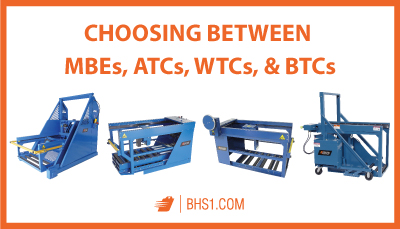We use cookies to make your experience better. To comply with the new e-Privacy directive, we need to ask for your consent to set the cookies. Learn more.
Choosing Between Mobile Battery Extractors, Automatic Transfer Carriages, Walkie Transfer Carriages, and Battery Transfer Carriages
Electric forklifts with side-access battery compartments offer the possibility for quick, safe change-outs with every shift — but you can only take advantage of this system with the right battery handling equipment. Choosing the ideal machine to safely extract and replace forklift batteries depends on the needs of your specific application, but how do you pick between similar types of battery extractors?
For instance, if you're looking for a single battery changing device for a smaller fleet — or a battery carriage that can function as a backup or portable battery handling in a large facility that already uses a dedicated Operator Aboard Battery Extractor System — take a look at four classes of BHS equipment in particular: the Automatic Transfer Carriage (ATC), the Walkie Transfer Carriage (WTC), the Mobile Battery Extractor (MBE), and the Battery Transfer Carriage (BTC).
All four options will improve productivity and safety during battery changes. They're all mobile, so you can take them virtually anywhere in the facility. But beyond that, they each provide different benefits for different applications. In order to decide which one is right for you, ask yourself the following questions:
-
How large is the forklift fleet?
-
How many shifts does your facility run?
-
How many times per day, then, do you have to change out forklift batteries?
-
Do you have a spare powered pallet jack available?
-
Do you have a dedicated battery room or do you run a park & charge application?
-
How wide are the aisles in your facility?
Once you've established exactly how many battery changes per day your operation requires, the equipment you already have available, and the size restrictions of your aisles, you can consider the relative advantages of the ATC, the WTC, the MBE, and the BTC. Here's a brief, introductory guide to these forklift battery handling solutions:
Mobile Battery Extractor

The MBE is a complete, self-contained battery changing unit. It's powered by a 24-volt powerhead that allows you to take it anywhere — as long as you have aisle widths of 16 feet or greater (17 feet for the 5,000-pound capacity model). The powerful extractor arm pulls forklift batteries with a vacuum grip, which requires enough surface area to attach, so the MBE is suitable for use with ultra-slim battery cases only when ordered with the optional magnet extraction, in lieu of vacuum.
Mobile Battery Extractors are recommended for up to 50 change-outs per day, and only with forklifts that are configured for side extraction. They're remarkably quick, and can swap out a forklift battery in 5 minutes or less. The MBE is an ideal model for small to medium-sized forklift fleets, or even larger fleets that don't run multiple shifts per day.
Automatic Transfer Carriage
Like the MBE, the ATC offers quick, hassle-free side-extraction for forklift batteries with a hydraulic-powered extraction arm and capacities of 4,000 and 5,000 pounds, depending on the model. However, the ATC requires an existing powered pallet truck for mobility. You'll need to factor that into your total cost to get the most benefit from this model.
Various models of the ATC offer a wide variety of sizes for the battery compartment, allowing virtually any fleet access to batteries without an unnecessarily wide footprint. Choose compartments that are between 24 and 42 inches wide, with optional extension beds for longer batteries.
The ATC functions best when it's used for up to 20 battery changes per day on a side-extraction fleet. This is a great option as a portable battery extractor, for removing batteries in the aisles, or even as a single solution for smaller fleets.
Walkie Transfer Carriage
The Walkie Transfer Carriage pulls batteries from side-extraction compartments with a mechanical hand wheel, so there's no need for any power supply on the unit itself. It mounts easily to your existing pallet jack, like the ATC. Also like the ATC, the WTC is available in a variety of battery compartment widths to accommodate larger batteries and/or narrower aisles.
Like its powered counterparts, the WTC is made from sturdy steel with an acid-resistant powder coating; these units were made with the expectation that they'd come into contact with electrolyte every now and then.
While the manual functionality of this model can be an advantage, it does add a little bit of time to battery changes. Change-out time for the WTC averages between 5 and 8 minutes. This model functions best at the rate of 10 changes per day.
Battery Transfer Carriages
The BHS family of BTCs offers every available combination of manual and powered functionality. Battery room operators on a budget might choose the BTC-WINCH, an entirely manual battery handling device with large phenolic wheels, a winch for battery extraction, and a manual hydraulic jack for vertical positioning.
Users who need slightly faster change-outs can choose the BTC-MPPAE, which includes fully powered extraction and vertical travel via an enclosed 12-volt DC hydraulic power unit. Other models offer manual extraction with a hand wheel instead of a winch; a hand-wheel extractor with a powered lift function; and a powered battery extractor arm with a hand jack that adjust the height of the battery bed.
Within each of these models, there's a whole suite of customization options, including various sizes of battery compartments, a vacuum extraction grip for powered models, and even a track-mounted kit that creates a fixed battery changing area. Each of these models are best for lighter-duty applications that only require 5 changes per day or fewer.
No matter which model is right for your application, all BHS equipment is made to perform with safety and efficiency in mind. To learn more about these and other models of battery handling equipment, call BHS today at 1.800.BHS.9500.
